Monday, June 7
Paula: "Jambo, Jambo" was 6:30 A.M. today and the sun rose shortly thereafter (somehow David found himself outside his tent!). When camping, the staff always wakes us up with this greeting (jambo means in Swahili) and awaits our response to indicate that we are awake. Today was the last of our nine days of camping in Tanzania and except for the latrines, we will all find ourselves missing "Jambo Jambo" and our other experiences "camping in the great outdoors" (as Steve exclaims repeatedly each day).
After packing up and having breakfast, we went to visit a family from the Datoga tribe living very near our camp. The Datogas, who are heavily focused on agriculture and herding, are slowly invading the Hadza's territory. Despite this, today we observed a riendly relationship between this family and Asanti (our Hadza friend). In fact, Asanti led us to the Datoga home and even wanted to be in some of the pictures we took of the Datoga family.
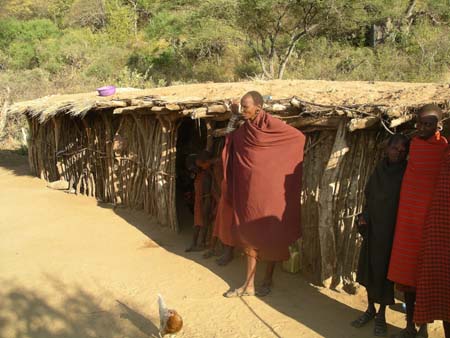 When
we arrived, the father greeted us with the traditional, "Sayou"
(which means hello in Datoga) and began by giving us a tour of his home. The
house is made of tree branches filled in with cow dung - very similar to the
Maasai homes. The roof is covered in dirt which helps keep it cool inside
especially during the warmer months of September and October.
When
we arrived, the father greeted us with the traditional, "Sayou"
(which means hello in Datoga) and began by giving us a tour of his home. The
house is made of tree branches filled in with cow dung - very similar to the
Maasai homes. The roof is covered in dirt which helps keep it cool inside
especially during the warmer months of September and October. 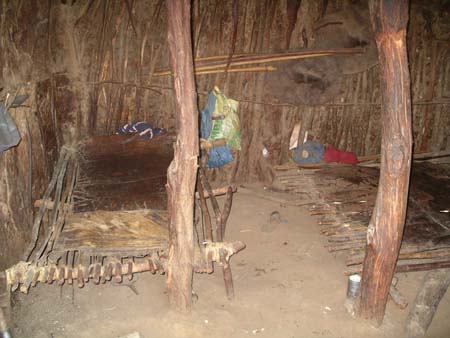
The house is divided into two parts. One side is strictly for the men to
sleep in and has goats in a separate pen located immediately behind their
beds. This allows them to hear the sounds of any invading predators that (e.g.
leopards) try to attack their animals. Within the men's area we saw their
spears, bows and arrows, shields and branding tools. We learned that the men
are responsible for the animals while women take care of the children and
the fields.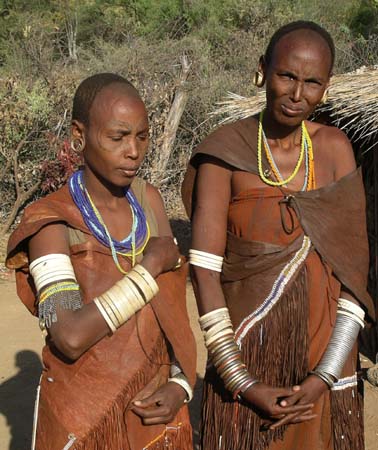
The women's quarters makes up the larger second section of the house. Here there is a large bedroom for the women and children, an area for cooking on an open fire as well as a room for drying and storing produce from their fields. Kitchen equipment consists of a grinding stone and a few scattered pots and cooking utensils. Beds are raised and made of sticks covered with animal skins. There are no windows or chimneys.
We learned that this house belonged to one of the man's two wives (they are
the two women pictured here). He decides each day on where he will sleep that
night. When he spends the night in the house that we visited, the girls all
crowd into a separate area so that the man and wife can sleep together. 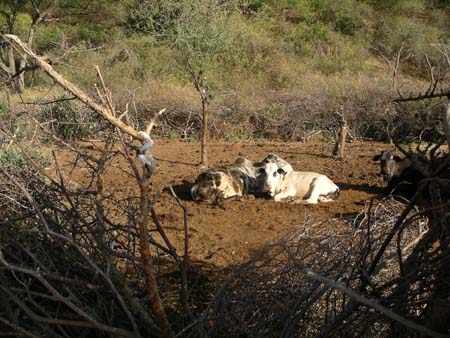
The home and animal pens are fenced in by thorny acacia branches. The family has cows, chickens, goats, donkeys and two dogs. All these animals live in close proximity to the family and certainly contribute to the swarms of flies that we saw all around their home.
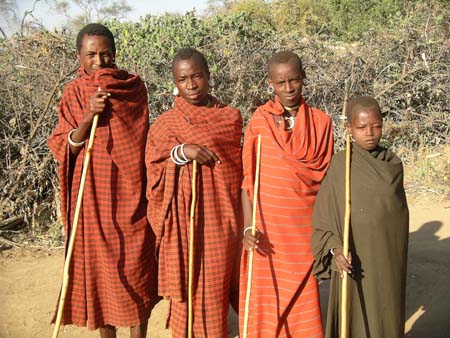 Once
all out of the house, we were surprised to see the size of this family. The
father has two wives and eleven children. His first wife lives in the home
we toured with her nine children. The other wife lives nearby with two sons
and they had come to welcome us as well. Dowries payments for wives among
the
Once
all out of the house, we were surprised to see the size of this family. The
father has two wives and eleven children. His first wife lives in the home
we toured with her nine children. The other wife lives nearby with two sons
and they had come to welcome us as well. Dowries payments for wives among
the 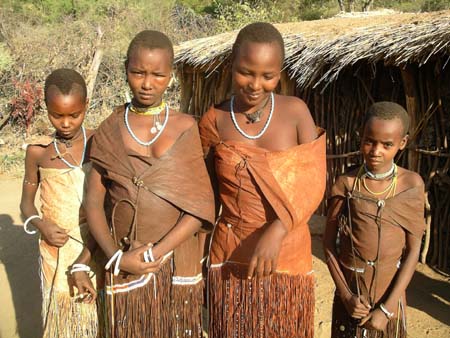 Datoga
are currently five cattle plus 40 liters of honey!
Datoga
are currently five cattle plus 40 liters of honey!
Once we had completed the tour of the home, the family appeared eager to interact with us. They loved having their pictures taken and kept asking Steve to capture one more pose! Of course, they all surrounded him after each shot to view their image on the camera. They were also very interested in our jewelry and showed us the beautiful beaded goat skins that they wear.
The members of the Datoga family kept talking to us and were asking questions even though we often didn't understand or respond. Steve finally decided to try and teach them a few words in English and they took great pleasure in trying to sound out the words. They seemed disappointed when we waved goodbye and the visit was a neat way to end our experiences here in the Kidero region.

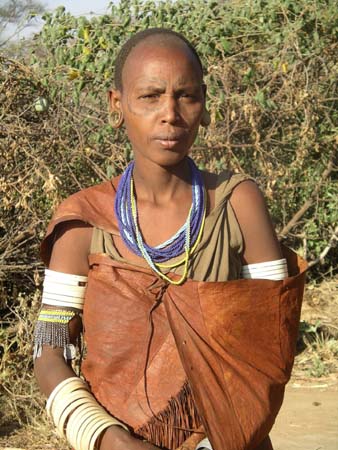
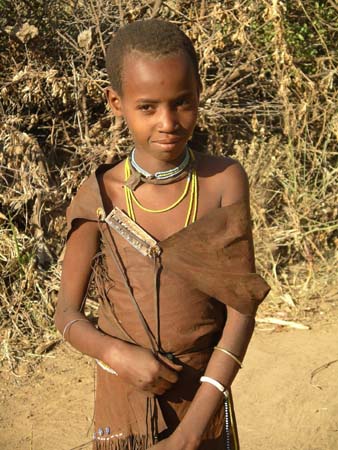
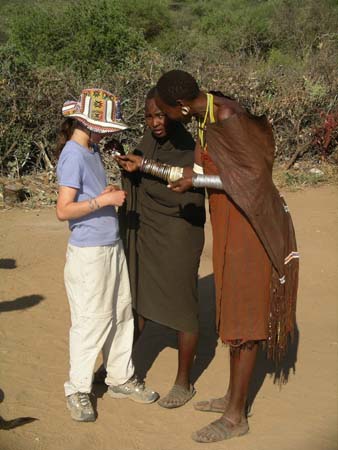
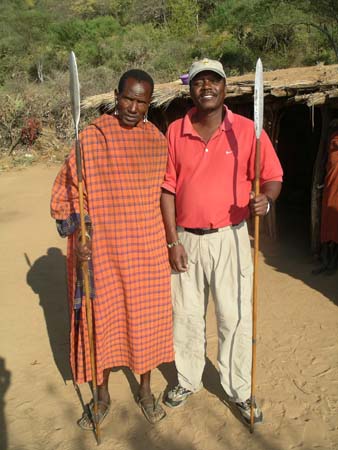
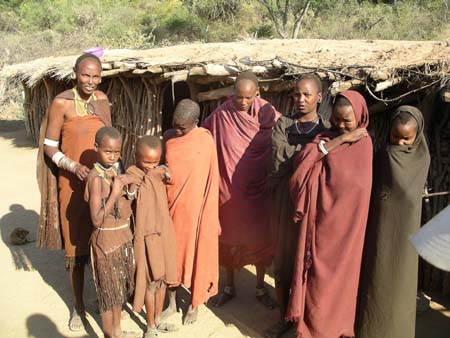
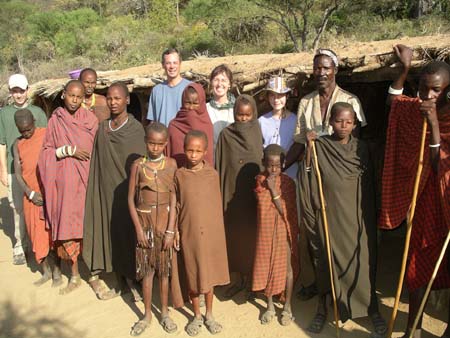
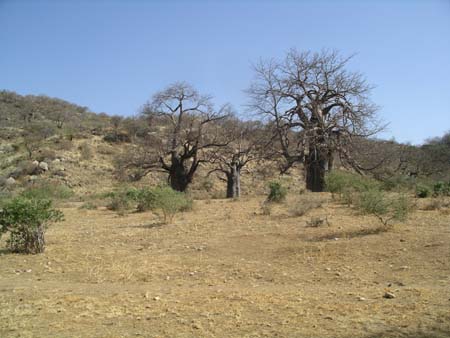
Our return to Karatu was uneventful yet rugged. We realized after driving
almost 3 ½ hours that we had seen only one other vehicle (a very full
public bus) and decided this was an interesting way to measure how remote
an area this really is. We were content to settle back in at Gibbs Farm where
we had spent two days before beginning our adventures with the Hadza. We took
advantage of the peaceful surroundings this afternoon by relaxing and catching
up our reading and writing. Just for fun, we visited the farm animals 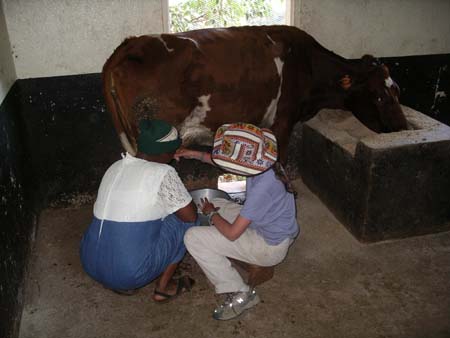 kept
here and Katie helped milk one of the cows. We joked about the fact that we
had to come all the way to Tanzania for Katie to have her first cow-milking
experience!
kept
here and Katie helped milk one of the cows. We joked about the fact that we
had to come all the way to Tanzania for Katie to have her first cow-milking
experience!
Tomorrow we head to Tarangire, a wildlife park best known for its elephants. This will be the last stop on our safari and we are finding it difficult to believe that our three weeks in Tanzania are quickly coming to an end.
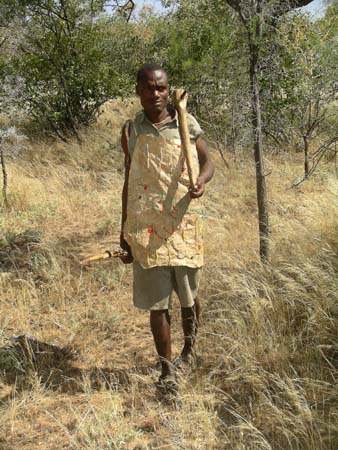
Katie's Kwick Kwacks: My Impressions of the Hadzas. The two short days we spent with the Hadza people, were some of the most exotic on the trip for us. At first the idea of visiting a hunter-gatherer tribe in the middle of Tanzania seemed pretty far fetched to me - none of us knew what to expect. In the end, however, it ended up being a great experience which deepened our understanding of how early man used to live. The following paragraphs discuss some of my impressions of this experience and what I learned from it.
"The men eat the meat and the women eat the berries and roots." We all exchanged confused glances. After a moment of thought Dad said, "Don't they share the things they collect"? Our guide simply smiled and said, "That's not the way they do it here." I was beginning to understand what he as trying to say, yet it just didn't seem to make sense. The women pick berries and dig roots to feed themselves. As soon as a berry comes off of the bush it goes into their mouth - they pick and eat until their stomachs are full. I didn't sense any type of gathering in this process. The men go out hunting. If they catch something they start a fire with sticks wherever they killed the animal, put it in the fire and then eat it. They hunt until they aren't hungry anymore. The only time they bring any back to the village is if they have leftovers which they can't eat. Every man is for themself. It still wouldn't register in my mind - women and men seemed to be from different tribes. Their diets were completely different. I also didn't understand why they don't save food in case there was a drought or something which limited the amount of food available. Was it out of ignorance? During that first hour with the Hadzas, we felt completely lost with people who seemed to have no common sense at all.
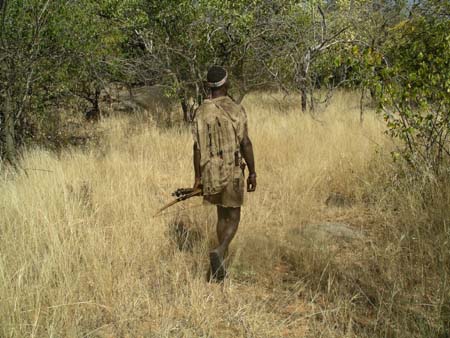 We
woke up the next morning on a quest for understanding of these people who
lived so differently than we could ever imagine. After breakfast we went out
hunting on the escarpment with the men. The man leading the hunt walked slowly
but steadily with his head held straight ahead and his bow held tightly. He
didn't seem to be too concentrated on looking around to find animals - he
looked powerful, wise, and remarkably patient. It was obvious that he was
the leader of the village.
We
woke up the next morning on a quest for understanding of these people who
lived so differently than we could ever imagine. After breakfast we went out
hunting on the escarpment with the men. The man leading the hunt walked slowly
but steadily with his head held straight ahead and his bow held tightly. He
didn't seem to be too concentrated on looking around to find animals - he
looked powerful, wise, and remarkably patient. It was obvious that he was
the leader of the village.
We were walking normally when all of a sudden he crouched low behind the
grasses. It was completely automatic. Now all of his attention was focused
on the rustling bushes about 50 yards away. We all grew excited. I thought
for sure he would shoot, but instead he moved in a sideways stalking motion
around the area of the bushes. He reminded me so much of the lions we have
watched hunting. The transition from a relaxed walking mode to a tense hunting
mode seemed completely instinctual. The small dik-dik finally spotted the
predator and scurried away. Asani (our leader) immediately rose back to his
feet and continued walking at a normal pace. It was over. I felt an urge to
say something like, "Nice try" or "There might be more in this
area," but this seemed unnecessary. He was on his way again. Both Asani
and Hamisi (the helper) seemed unfazed. 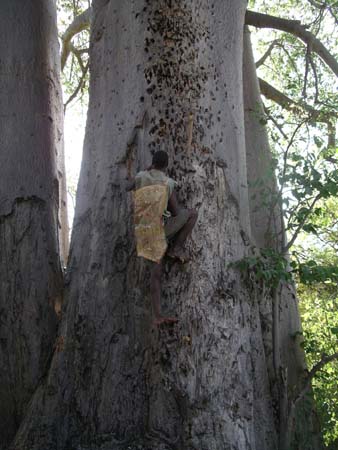
A little while later Hamisi stopped. He was staring up in a tree. Nassibu told us that he had seen some bees fly out of a part of a branch. We watched in amazement as Hamisi effortlessly climbed the thorny tree to reach the hive. After using his axe to open the hive he began to pick at the honey comb and slurp it into his mouth. I didn't see anything he had brought to collect the honey in, and before I could ask he was climbing back down the tree and on his way again. It was just a little snack. While we walked we saw Hamisi continuously stopping at bushes to eat berries.
When we got back from our unsuccessful hunt, we asked Hamisi if he was hungry. He told us he was very hungry, and therefore going out to hunt later. While David and Dad went hunting with him, Mom and I dug roots with the women. The women all stopped at the first tree they saw to look for roots in. It was tough work, and we were surprised to see that they kept only a small portion of the roots. It didn't seem like very much to us. To our surprise as soon as they had finished with that tree, they turned back to the village. They could easily have gone to another nearby tree to get more, but they were satisfied with only a few pieces of root for each woman. They left none to save for later.
The men came back from their hunt with several bushbabies and an owl. They wasted no time in eating these prizes. We watched as they simply threw the animals into a fire and then ate them. Every last scrap of meat on the bones was devoured. They also saved some of the owl feathers to use for their arrows. When they were full, there were still two bushbabies left. They decided to bring them back to the women. We all went to bed that night with a greater appreciation for how the people here live and survive. This was our day with the Hadzas, one we will never forget.
 Spending
time with the Hadzas greatly helped me to understand how different the life
style of early man was from our lives today. The way that the Hadza people
survive is unlike anything we have ever seen before - the people have remained
unchanged for thousands of years, hunting and gathering every day. The Hadza
live by the moment - all that they are focused on is having enough food for
that day and they don't worry about the next. They don't care about the benefits
of saving things or preparing for the future.
Spending
time with the Hadzas greatly helped me to understand how different the life
style of early man was from our lives today. The way that the Hadza people
survive is unlike anything we have ever seen before - the people have remained
unchanged for thousands of years, hunting and gathering every day. The Hadza
live by the moment - all that they are focused on is having enough food for
that day and they don't worry about the next. They don't care about the benefits
of saving things or preparing for the future.
At first we thought that the people didn't have any common sense. After spending
a full day with them, however, we have realized that they just have a different
perspective on life than we are used to. Most people today think about what
they can do to improve their way of doing things, and how to make changes
with positive long term effects. The Hadzas and other past hunter-gatherer
groups, however, receive life as it comes, and take advantage of all opportunities
that come their way. 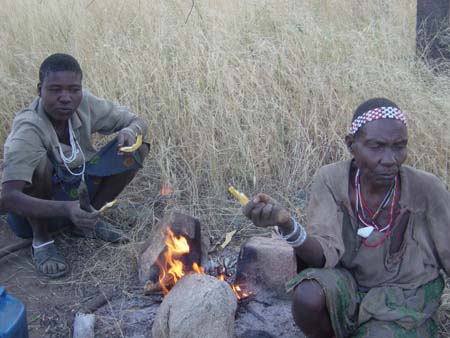
The Hadza's life style is so different, that the Tanzanian government is struggling to decide how these people should appropriately fit into their society. On one hand they feel that they should be left alone to live their own ways. On the other they feel that these people should somehow fit into modern life today. Studies show that although the Hadza people have a more limited diet than most of us, they are generally just as healthy. The problem for these people, however, is that other tribes are destroying their land, and at the same time promoting their ways of life and religion. Time will tell how long these people will survive - most researchers now think that they will last only a few more years if they can't establish some kind of defense. This makes me feel very fortunate to have seen these people in their original state, and I hope to spread my findings to others around me. The Hadza people live a full life, and we need to preserve and remember this ancient culture for as long as man lives.
